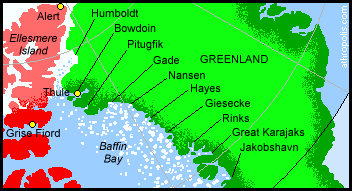
 Iceberg Factory While many icebergs that reach the North Atlantic Ocean originate in the Eastern Canadian Arctic Islands, the vast majority of them come from the major glaciers of West Greenland. There are about 100 iceberg producing glaciers in the range between the Humboldt and Jacobshavn glaciers. These are among the fastest moving glaciers in the world, pushing ice toward the sea at up to 7 km / 4½ miles per year! The number of icebergs that are calved each year varies, but it is estimated that up to 40,000 can enter the waters around Greenland each year. A very small percentage of those make it as far south as Newfoundland, Canada. The bergs that reach that far probably entered the water more than a year before. They often spend a year or more in cold Arctic bays melting slowly (or not at all in winter) until they eventually pass through the Davis Strait and catch the cold Labrador current south. The glacial ice that icebergs are made of may be many thousands of years old, but once they start floating south, their life is almost over. Icebergs rarely last more than a year at this point.
Click pictures for more information and credits. Library: Icebergs, Glaciers, Arctic Links: Icebergs, Glaciers, Arctic Map: Source of North Atlantic Icebergs Arctic Maps & Weather Reports |

|
DICTIONARY: Just "double-click" any unlinked word on this page for the definition from Merriam-Webster's Student Electronic Dictionary at Word Central. |

|
ARCTIC LIBRARY & GLOSSARY: Check this section for an index of the rest of the things you really need to know about the Arctic. |

|
ARCTIC MAPS & WEATHER REPORTS: Maps of the Northwest Passage, explorers' routes, iceberg sources, Nunavut, the Arctic by treeline, temperature... |

|
ARCTIC LINKS: Even more information! Links to sites related to the Arctic and "Iceberg: the Story of the Throps and the Squallhoots". |

|
GUIDE TO ARCTIC SUNRISE & SUNSET: How much sunlight or darkness is there in the Arctic on each day of the year? |
to is the property of their respective owners, and Athropolis is not responsible for their content.